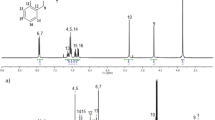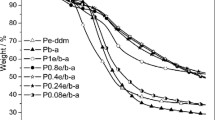Abstract
In this study, a polybenzoxazine, (PPab) based on phenol and 4-aminomethyl benzoate and its composites containing various amounts of 3-hydroxyphenylboronic acid, (HB) were prepared by stepwise curing. It has been found that thermal properties of composites were improved as the amount of HB introduced was increased. The improvements in thermal characteristics were associated with condensation reactions of hydroxyl groups of polybenzoxazine and ester groups on the aniline linkages yielding a highly cross-linked structure. In addition, application of direct pyrolysis mass spectrometry, DP-MS, technique supplied information pointing out generation of a boroxine network by self-condensation reactions of B-OH groups.







Similar content being viewed by others
References
Wang DC, Chang GW, Chen Y (2008) Preparation and thermal stability of boron-containing phenolic resin/clay nanocomposites. Polym Degrad Stab 93:125–133
Doğan M, Bayramlı E (2011) Synergistic effect of boron containing substances on flame retardancy and thermal stability of clay containing intumescent polypropylene nanoclay composites. Polym Adv Technol 22:1628–1632
Wang J, Jiang N, Jiang H (2010) Micro-structural evolution of phenol-formaldehyde resin modified by boron carbide at elevated temperatures. Mater Chem Phys 120:187–192
Xu P, Jing X (2010) Pyrolysis of hyperbranched polyborate modified phenolic resin. Polym Eng Sci 50:1382–1388
Espinosa MA, Galia M (2003) Synthesis and characterization of benzoxazine-based phenolic resins: crosslinking study. J Appl Polym Sci 90:470–481
Ning X, Ishida H (1994) Phenolic materials via ring- opening polymerization of benzoxazines: effect of molecular structure on mechanical and dynamic mechanical properties. J Polym Sci Part B Polym Phys 32:921–927
Li H, Yao D, Fu Q, Liu L, Zhang Y, Yao X, Wang Y, Li H (2013) Anti-oxidation and ablation properties of carbon/carbon composites infiltrated by hafnium boride. Carbon 52:418–426
Wang S, Wang Y, Bian C, Zhong Y, Jing X (2015) The thermal stability and pyrolysis mechanism of boron-containing phenolic resins: the effect of phenyl borates on the char formation. Appl Surf Sci 331:519–529
Yagci Y, Kiskan B, Ghosh NN (2009) Recent advancement on polybenzoxazine-a newly developed highperformance thermoset. J Polym Sci Polym Chem 47:5565–5576
Chutayothin P, Ishida H (2010) Cationic ring-opening polymerization of 1,3-benzoxazines: mechanistic study using model compounds. Macromolecules 43:4562–4572
Jubsilp C, Takeichi T, Rimdusit S (2011) Polymerization kinetics: handbook of benzoxazine resins. Elsevier, New York
He Z, Chen J, Keum JK, Szulczewski G, Li D (2014) Improving performance of TIPS pentacene-based organic thin film transistors with small-molecule additives. Org Electron 15:150–155
He Z, Asare-Yeboah K, Zhang Z, Bi S (2019) Self-assembly crystal microribbons with nucleation additive for high-performance organic thin film transistors. Jpn J Appl Phys 58:061009
He Z, Zhang Z, Bi S (2019) Long-range crystal alignment with polymer additive for organic thin film transistors. J Polym Res 26:173–180
He Z, Zhang Z, Bi S, Asare-Yeboah K, Chen J (2020) Ultra-low misorientation angle in small-molecule semiconductor/polyethylene oxide blends for organic thin film transistors. J Polym Res 27:75–81
Chozhan C, Alagar M (2009) Gnanasundaram P synthesis and characterization of 1,1-bis(3-methyl-4-hydroxy phenyl)cyclohexane polybenzoxazine–organoclay hybrid nanocomposites. Acta Mater 57:782–794
Ishida H, Low HY (1998) Synthesis of benzoxazine functional silane and adhesion properties of glass-fiber-reinforced polybenzoxazine composites. J Appl Polym Sci 69:2559–2567
Low HY, Ishida H (1999) An investigation of the thermal and thermo-oxidative degradation of polybenzoxazines with a reactive functional group. J Polym Sci B Polym Phys 37:647–659
Huang MT, Ishida H (1999) Investigation of the boron nitride/polybenzoxazine interphase. J Polym Sci B Polym Phys 37:2360–2372
Zhang R, Lu X, Lou C, Zhou C, Xin Z (2019) Preparation of diamine-based polybenzoxazine coating for corrosion protection on mild steel. J Polym Res 26:29–36
Yu X, Zhang K (2020) Studies on the isomeric effect of nitrile functionality on the polymerization and thermal properties of ortho-norbornene-based benzoxazine resins. J Polym Res 27:130–137
Wang S, Jing X, Wang Y, Si J (2014) Synthesis and characterization of novel phenolic resins containing aryl-boron backbone and their utilization in polymeric composites with improved thermal and mechanical properties. Polym Adv Technol 25:152–159
Si J, Xu P, He W, Wang S, Jing X (2012) Bis-benzoxazine resins with high char yield and toughness modified by hyperbranched poly(resorcinol borate). Composites A: Appl Sci Man 43:2249–2255
Ramdani N, Derradji M, Wang J, Mokhnache EIQ, Liu WB (2016) Improvements of thermal, mechanical and water-resistance properties of polybenzoxazine/boron carbide nanocomposites. JOM 68:2533–2542
Liu Y, Zhang X, Yang X (2013) A novel hyperbranched polyborazine and its reactive blend with benzoxazine thermosets. Polym Eng Sci 53:507–515
Wang S, Jia Q, Liu Y, Jing X (2015) An investigation on the effect of phenylboronic acid on the processabilities and thermal properties of bis-benzoxazine resins. React Funct Polym 93:111–119
Telli AH, Hacaloglu J (2018) Effects of aromatic diboronic acid on thermal charateristics of polybenzoxazines based on phenol and aniline. Europ Polym J 108:182–190
Ipek H, Hacaloglu J (2018) The effect of aromatic diboronic acid on characteristics of polybenzoxazine based on phenol and 4-aminomethylbenzoate. J Polym Res 25:263–269
Author information
Authors and Affiliations
Corresponding authors
Ethics declarations
Conflict of interest
The authors declare that they have no conflict of interest.
Additional information
Publisher’s note
Springer Nature remains neutral with regard to jurisdictional claims in published maps and institutional affiliations.
Highlights
• Polybenzoxazine composites were prepared by using aromatic boronic acid.
• Improvement in thermal characteristics of polybenzoxazine was detected.
• Interactions between functional groups of benzoxazine and boronic acid were detected.
Rights and permissions
About this article
Cite this article
Ipek, H., Hacaloglu, J. The effect of 3-hydroxyphenylboronic acid on thermal characteristics of polybenzoxazine based on phenol and 4-aminomethylbenzoate. J Polym Res 27, 245 (2020). https://doi.org/10.1007/s10965-020-02221-2
Received:
Accepted:
Published:
DOI: https://doi.org/10.1007/s10965-020-02221-2




